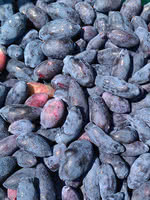Mon-Fri 9am - 5pm Mountain time
Black Elderberry vs Blue Banana Haskap (Honeyberry)
Sambucus canadensis
Lonicera caerulea Blue Banana
NOT AVAILABLE THIS SEASON - MIGHT RETURN
NOT AVAILABLE THIS SEASON - MIGHT RETURN
Black Elderberry is a deciduous shrub native to eastern North America. You can plant this shrub in moist areas and it will help stabilize your soil. You can also use it on rural properties anywhere you'd use a lilac.
Black Elderberries are considered to be partially self-pollinating. So while they will still produce some berries without cross-pollination, planting with another variety will increase yields. Consider planting with Ranch Elderberry or Bob Gordon Elderberry.
Warning: the seeds, stems, leaves, roots, and uncooked berries of the Black Elderberry are poisonous to humans when eaten in quantity. You should cook the berries to make them safe for human consumption.
The Blue Banana Haskap is a fruit-bearing shrub that produces medium-sized oval berries that are quite sweet. Their taste is typically described as something between a raspberry and a blueberry. Its small white flowers bloom in April, with harvest time being mid-June to mid-July. The berries are juicy, and are great for fresh eating and using in preserves.
The Blue Banana Haskap, or Blue Banana Honeyberry is a cold-hardy cultivar.
Blue Banana is a late pollinating variety. Pair with other late pollinators to have a higher yield.
Blue Stuart is a great companion variety.
Black Elderberry Quick Facts
Blue Banana Haskap (Honeyberry) Quick Facts
Toxicity: leaves, stems, and uncooked berries are poisonous to humans

